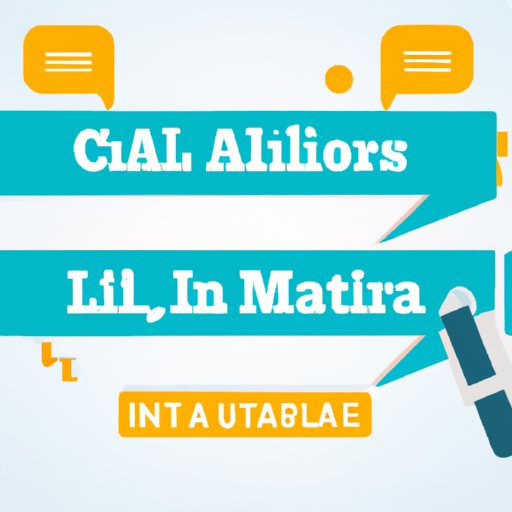
I. Introduction
When you’re writing a research paper, it’s important to give credit to the sources you used to support your ideas. Proper citation shows that you’ve done your due diligence and adds credibility to your work. MLA (Modern Language Association) style is a common format used in academic writing for in-text citations. However, it can be confusing and overwhelming to understand the rules and conventions of this citation style. That’s where this comprehensive guide comes in.
This article is designed for students, researchers, and academics who want to learn how to cite in-text using MLA style. Whether you’re just starting out or have been using MLA style for years, this guide will provide all the information you need to ensure your citations are accurate, complete and comply with MLA conventions.
II. Step-by-Step Guide
The process of in-text citation using MLA style involves several key steps. These steps include identifying the sources you used, formatting your citations, and including them in your paper. Here are the key steps to follow:
- Identify the sources you used in your research. This can include books, journal articles, websites, videos, and other forms of media.
- Determine what information is required for each type of source. This can include information such as author names, publication dates, page numbers, and article titles.
- Format your citations correctly using MLA conventions. This involves placing in-text citations within your paper, as well as providing a works cited page at the end of your paper.
- Include all necessary information in each citation to ensure that your readers can locate the sources you used.
For example, if you were citing a book using MLA style, your in-text citation would follow this format:
(Author’s Last Name Page Number)
For instance,
(Collins 65)
Make sure to provide a works cited page entry for each source you used that includes all the necessary information.
III. Common Mistakes
While MLA citation may seem straightforward, there are common mistakes that many people make. These mistakes can lead to missing or incomplete citations, which could result in plagiarism accusations and negative consequences for your grade or reputation. Here are some of the most common mistakes to avoid:
- Failing to include page numbers in your citations
- Confusing publication dates with access dates for online sources
- Incorrectly formatting titles of books, articles, and websites
- Misattributing sources by citing the wrong author or publication
To avoid these mistakes, make sure to double-check all the information before you finalize your citations. Use proper formatting and pay close attention to details like page numbers and publication dates.
IV. Explaining Why
Proper citation in MLA style is important for several reasons. First, it shows that you’ve done your research and supports the credibility of your paper. Second, it allows your readers to locate the sources you used which can help them further their own research. Finally, and most importantly, it’s the ethical thing to do. Crediting someone else’s ideas and hard work just makes sense.
Failure to properly cite your sources can have serious consequences. You could lose marks, fail the assignment or even the course, or face penalties for academic misconduct. Such penalties could negatively impact your entire academic career. Proper citation shows that you take your academic work and intellectual honesty seriously.
V. Video Tutorial
This video tutorial offers a step-by-step guide to in-text citation using MLA style. It covers everything from identifying sources to formatting your citations to including your works cited page. You will also learn how to use online tools to format your citations.
The video is designed to provide hands-on instruction and reinforce what you’ve learned throughout the article. It also offers tips and tricks for making the citation process easier and more efficient.
VI. Quick Reference Guide
This quick reference guide provides an easy-to-use summary of MLA in-text citation. It offers concise instructions and examples for each step of the process, including how to cite books, articles, and websites. Here are some of the key points to keep in mind:
- In-text citations give the author’s last name and the page number(s) where the cited information can be found.
- The works cited page alphabetically lists all of the sources you used in your paper and provides bibliographic information for each source.
- Source information can vary, depending on the type of source. For example, books require the author’s name, title, publisher, and publication date, while online sources require information like the URL and date accessed.
This quick reference guide is a handy tool that you can use to help ensure your citations are accurate and consistent.
VII. Alternative Guides
While this guide is comprehensive and detailed, there are other resources available that can help you with in-text citation using MLA style. One such alternative is the Purdue Online Writing Lab (OWL).
The OWL site offers an overview of MLA citation style, including how to cite a variety of sources. It provides step-by-step guidance and examples to help you ensure that your citations are accurate and complete. The OWL site also offers additional resources, such as tips for avoiding plagiarism and citation exercises.
When considering other resources, keep in mind your individual needs as a writer and what best suits you.
VIII. Conclusion
In-text citation using MLA style can seem tricky, but by following this guide, you can ensure that your citations are accurate and consistent. This article provided a comprehensive overview of the in-text citation process, outlining the key steps to follow and providing detailed examples. We also covered common mistakes to avoid, the importance of proper citation, a video tutorial, a quick reference guide, and alternative guides. By following the rules and conventions of MLA style, you can support the credibility of your research and avoid any negative consequences for academic misconduct.
Be sure to bookmark or share these resources with anyone who may find them helpful.





